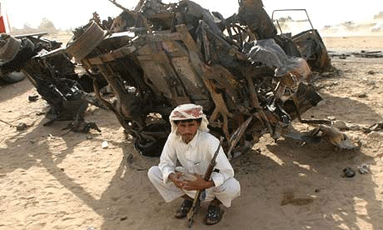
[Salon Magazine recently published an interview with Gregory Johnsen on the recent attacks against alleged al-Qaeda sites in Yemen. Here is a brief excerpt from the interview. The whole piece can be found at salon.com.]
Glenn Greenwald: My guest today on Salon Radio is Gregory Johnsen, who is an expert on Yemen; he’s a Ph.D. candidate in Near Eastern Studies at Princeton University and has advised the U.S. and British governments on issues relating to Yemen. Thanks very much for joining me today.
Glen Greenwald: How would you characterize what is being called al-Qaeda in Yemen in that spectrum, and how significant of a threat it is really to the United States, not within Yemen, but outside of Yemen and in the homeland?
Gregory Johnsen: Well, let me talk about it this way, if I can. This is the second incarnation of al-Qaeda in Yemen. Immediately after September 11th, we had what I like to term the first phase of the war against al-Qaeda. This lasted essentially from, say, the USS Cole attack in 2000 and really the September 11th attacks in 2001, up through November 2003. So, in this phase, the US and Yemeni governments partnered very closely. There was the drone strike in November 2002 that I mentioned earlier, and this was largely, at least for al-Qaeda, a reactionary war.
Throughout the 1990s, al-Qaeda had often thought of Yemen as sort of a refuge where they could come, relax; the Yemeni government ignored them as long as al-Qaeda ignored the government and didn’t carry out any attacks. It was essentially what could best be called a tacit non-aggression pact between the two. Now, after September 11th, that of course all changed; President Saleh was very worried that Yemen would be on the US hit list, and so he cooperated quite closely with the US government after the strike in November 2002. One year later, the Yemeni government arrested Abu Ali al-Harethi’s replacement, so really by November 2003, al-Qaeda in Yemen had been largely defeated by the US and Yemeni governments.
Then there’s a period from about November 2003 to February 2006 where there’s very little, almost no al-Qaeda violence in the country. Then in February 2006 there’s a prison break of 23 al-Qaeda suspects including the individual I mentioned earlier, Qasim al-Raymi, as well as an individual named Nasir al-Wuhayshi. Both Qasim al-Raymi and Nasir al-Wuhayshi had spent time with Osama bin Laden in Afghanistan, trained in the camps there; Nasir al-Wuhayshi was actually a lieutenant, a personal aide to bin Laden – he fought with bin Laden at the Battle of Tora Bora before eventually moving to Iran and then being extradited back to Yemen where he stayed in jail until he escaped.
So from February 2006 up to today, we have this second phase of the war against al-Qaeda in Yemen. And this is when al-Qaeda has really become a threat, because they’ve certainly learned from the first phase. They changed a lot of their tactics, and since February ’06 up until now, they’ve done a very good job of really building a durable infrastructure that can sustain and withstand the loss of key leaders, so when you assassinate cell leaders, you don’t find the organization crumbling down around himself. And in January of 2009, they moved from being what you could call a local chapter of al-Qaeda just based in Yemen, into more of a regional franchise, this al-Qaeda in the Arabian peninsula, which is the name that they use today.
Since then they’ve really been working to almost match their actions to their rhetoric, so their rhetoric says that they want to be an organization that can carry out attacks throughout the region, that is, throughout the Arabian peninsula. And so you’ve seen this; they’ve targeted Saudi Arabia’s counter-terrorism chief, Mohammed bin Nayef, for assassination, they’ve launched other attacks into Saudi Arabia that were foiled before they could take place. But this is the real danger that they present right now, is not just in Yemen, but using Yemen as a launching pad for attacks throughout the region.